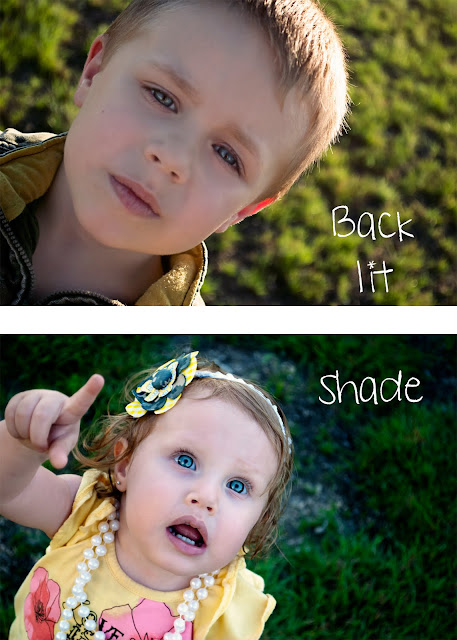The basics of getting a good picture
There are a few basic guidelines when trying to get a good image.
1. If you have a DSLR please use manual mode :)
a. Decide what f-stop you want (aperture). I usually do f1.4-f3 for single subject. f3-f5 for 2 or 3 subjects and f5-f8 for 4 or more.
b. Shutter speed. If you need a fast shutter speed, especially for kids go ahead and set it.
c. ISO if you have your f-stop and shutter speed selected and the lighting is still not enough take your ISO between 200-400 which allows more light, but also more noise.
d. White balance, you can set to auto or a custom white balance already set on your camera, or even measure your own white balance by selecting a white point. A blank white sheet of printer paper will suffice in the same lighting conditions you are shooting.
Next if you are shooting outside you want to have your lighting correct either by having your subject back-lit or in the shade. For back lit I prefer the sun 45* to either side for correct exposure of the subject and background (as well as adding sun flares). For silhouettes I prefer the sun to be directly behind the subject so I get a nice outline or halo effect.
The shade is also nice and adds an even diffused lighting to the image.
Notice my adorable doodle :)
Sun at 45* to either side, as well as directly behind....also in the shade will work.
You want to expose to the highlights on your subject. It is hard to retrieve details from blown out skin so it is best to avoid it by following the above tips.
Finally do NOT use your on camera flash!
If you are having trouble getting adequate light to your subject with the back lit option use a reflector....it can be as easy as getting a foam board from your local store such as Wal-Mart, the board that is used for science fair projects :)
Good luck all and happy snapping!




Beautiful site! You are truly an inspiration to those of us that shoot w a D40 =]
ReplyDeleteDo you ever use an external flash?
xoxo Jessica
The only flash I use is my strobes, other than that no way :)
ReplyDeleteThanks for the helpful tips!
ReplyDeleteMorgan, I have learned so much reading your tutorials. Thanks for this one, I am trying to get a better SOOC picture so I don't have to do as much "fixing". My problem is indoor shots. For instance, my son's 1st birthday today. I had to use the flash (and I also hate flash photography). But even with all my lights on and ISO at 400 (even tried 800) the shots were blurry or way to dark. Any suggestions??
ReplyDeleteThanks, Melissa (mzzmelissa)
I am having the same problem as commenter above. With indoor shots. I do not have studio equipment yet...so what do you suggest to add more light to get rid of the flash?
ReplyDeleteFirst of all, let me say I love these tutorials and have learned so much from them!
ReplyDeleteI hope Morgan doesn't mind me "busting in" here to answer the previous two posts (If you do, please tell me and I won't do it again. It won't hurt my feelings - I promise!)
Two things I've found that help drastically with overcoming indoor lack of light problems are:
(1) flash diffuser and bouncing the flash - bouncing obviously won't work with the on camera flash, but if you have a speedlite, point it to the ceiling, oh, and lower the output
(2) GE energy smart daylight light bulbs - I found these at walmart. They're the new swirly kind of bulbs (energy efficient ones) and they're 6500K. I got the 26 watt ones, which are suppose to be equivalent to 100 watt regular bulb, and they help quite a lot.
Hope that helps!
I don't mind at all :)
ReplyDeleteI've been trying to catch up.
She said everything I would have recommended :)
Great tips! Thank you!
ReplyDelete